What's in a Name: Part I

Elyse Kamibayashi, Former Senior Brand Strategist, and
Elliott Muñoz, Former Art Director
Article Categories:
Posted on
Or: "How to come up with 649 names you won't use"
So, you’re working on building or launching a new company, product, or service.
Maybe you’ve already started calling it something — a code name, or a word that means something to you and your team. But, as you get closer to putting it out into the world, you begin to wonder whether that name will mean as much to your audience as it does to you. Will they remember the name? Will they be able to pronounce it? Will they think to themselves, “that sounds like an interesting thing. I wonder what it’s about?”
Alternatively, maybe your company has been around for a long time, you’re realizing that it doesn’t seem to “fit” anymore. You've outgrown it. Or you never loved it but never had time to do anything about it.
Either way, you need a name. But just how does one come up with a name?
We wish we could say that there’s a special formula to naming — that Nike, Cadillac, and Apple were concocted using a specific blend of creativity, Greek, and the thesaurus. It would be nice if there were a recipe.

But there isn’t. Unless you're very, very lucky, the only way to come up with a great name is by going through the arduous process of coming up with a lot of names, many of which won’t be great. Thankfully, there is, at least, something of a process to that.
During this, the first of this two-part series on naming, we’re going to explore the unglamorous but necessary art of naming in bulk.
Grab your mental forklift, and let's begin.
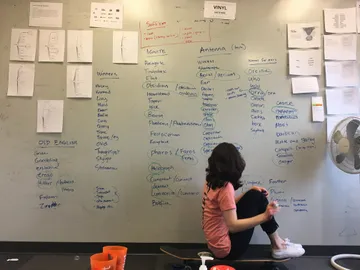
Step 1: Start with a brand strategy
Okay, we realize this is a big first step — a step with many steps, as it were. Why do we always start by creating a strategy, or studying the existing strategy?
For one thing, using the strategy as your starting point ensures that your name, just like everything else, will be consistent with your brand. After all, your strategy should be the foundation for everything — from your voice & tone to your logo.
But on an even more practical note, your strategy is a fountain of inspiration for coming up with names. After all, what is a strategy but a really good story? It should be jam-packed with themes and ideas that resonate with your audience — and that can be explored when you’re trying to come up with a word that resonates with that audience.
Which leads us to step 2.
Step 2. Use your strategy to identify focus areas for your brainstorming
Focus areas are really just a fancy name for “themes and ideas found in your strategy.”
When we were renaming The Great Courses Plus, our strategy explored the feeling you get (or rather, your brain gets) the moment you learn something new. It encompassed themes like curiosity and love of learning, but it also led us to questions like: what would you call a place that contains an endless hoard of fascinating information? What would you call a person on an endless quest for ideas? Is there a single word that captures what an “aha moment” feels like? From that "mind=blown" idea, we were able to derive several unique focus areas that could kickstart our brainstorming.
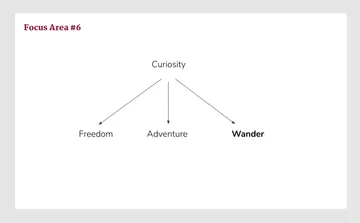
Some focus areas were more directly related to the original “mind=blown” idea — some evolved as we began to riff on the strategy. Each focus area became a sandbox we could play in when generating names. It meant that if we started hitting a wall with one focus area, we could find renewed inspiration with another.
In the end, we came up with 650 potential names, divided between six focus areas.
Were all the names winners? No (looking at you, Kwest). But we felt confident that we had come up with a set of names that explored every facet of our brand’s personality.
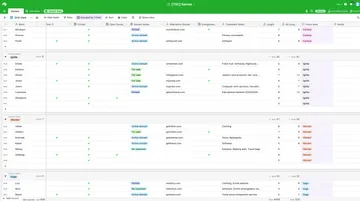
Side note: we do recommend doing preliminary domain name research on your names. As we repeatedly told our client team, we are not lawyers and couldn’t say definitively whether a name was trademark-able. But we could eliminate the ones that clearly wouldn’t be, thus avoiding heartbreak. Turns out, you can do a lot with GoDaddy and TESS (the Trademark Electronic Search System associated with the United States Patent and Trademark Office).
Step 3: Brainstorm with at least two people and ideally three or four
This might seem like a no-brainer, but it’s worth emphasizing. More people = more names. I’m constantly surprised and delighted by how each person’s life experiences and interests influence the kinds of names they come up with. During our work with The Great Courses Plus, we had one person on our team who previously worked as a handbag designer, and who had a treasure trove of arcane and fascinating words related to handbags and fashion. Another team member was in the middle of an exceedingly thorough podcast on British history, and not only had a wealth of obscure, Middle English words, but who could also regale us with stories about “hoards” (the correct archaeological term) of historical artifacts found in fields.
Related to this step: have fun. Waste a little time researching the origins of the term “motte-and-bailey.” Write down names that you might never use, but that bring you joy, like “rumspringa.” Savor the discovery of new words like “pochette.” You'll think more freely, which will lead to more and better names.
Step 4: Use your focus areas when you start to narrow the pool of names
It’s all fun and games till you have to start getting rid of names. After all, how do you know how many names to show the client team? When do you show them?
While there are no hard and fast rules for this step, we generally try to steer clear of the “big reveal” approach in favor of holding collaborative workshops.
When we worked with the Great Courses Plus, we cut down our 650 names to our top 40 — around 6-7 names per focus area. Some names were easy to nix — the domain name was too hard to get, too hard to pronounce, or too hard to spell, etc. When the culling got harder, the question shifted from: can people actually pronounce this name to does this name deserve to represent this focus area or are there others like it that are better?
During the workshop, we showed the client team our top 40, written on stickies in Whimsical. They readily applied the same line of thinking — not just saying “I don’t like this name,” but “I think there are other names that better represent this focus area.”
These were our top 10 (we snuck in an 11th):
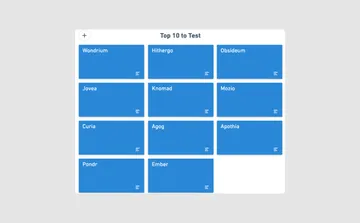
After some preliminary testing with their target audience, we were able to narrow to a top five.
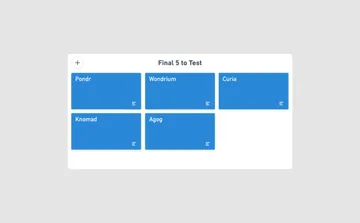
Out of these top five, only two came from the same focus area. That meant that we had a veritable cast of names, all representing different facets of the brand and its personality. Pondr and Curia, for example, evoked a sense of curiosity. Knomad hailed from our “wander” focus area — leaning into the idea of being on a constant quest for knowledge. Wondrium was inspired by the idea that the platform was an actual place where people could go to find glittering hoards of mind-blowing information. Agog came from our “aha moment” focus area. Having a variety of names enabled us to compare them based on what they stood for and what we wanted our audience to think of when they saw the name — rather than just what they sounded like.
One last note: it’s worth mentioning that dark horse names can play an important role, especially if you’re doing user testing.
Dark horse names are the ones you think are probably too risky — too bold, too weird, just too much. Not surprisingly, Agog was our dark horse. It captured the weirdness and intensity of a mind=blown moment, but we suspected it was almost too weird to work as a name. We put it through user testing along with the rest because we wanted to learn from our audience’s reaction. The reaction was, in most cases, not favorable. While our audience loved the weirdness and unexpectedness of the voice we used in our messaging and design, they seemed to respond to something more friendly and dialed-back when it came to the name. This insight helped inform our final decision — thus, Agog’s sacrifice was not in vain.
In conclusion (sort of)
If this feels like a lot of work for a name, it is. It has to be.
We always hope we’ll think of several amazing names within the first 30 minutes of brainstorming. Sometimes we do, and when that happens, we keep going. For one thing, the names seem to get better once we’ve allowed ourselves to get through 50 or so mediocre ones. But more than that, when it comes to naming, the goal is not efficiency. It’s thorough-ness. Clients don’t want to feel like they’re choosing the best name out of a handful of names you dreamed up in an hour or so. They want to feel like they’re choosing the best name that a team of 3 or 4 people could possibly think of.
So, if you’ve made it this far, congratulations. You’re half-way to a great name. Part II of this article will focus on the very different process of helping the client select a final name. It feels less like madly chucking things into your cart at Trader Joe’s, and more like cooking with the stuff you got at Trader Joe’s. It’s when we get to take our final names and give them a personality and a point of view by creating a logo and a tagline for each.